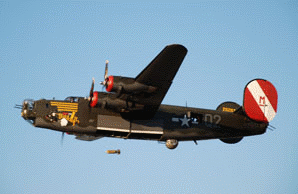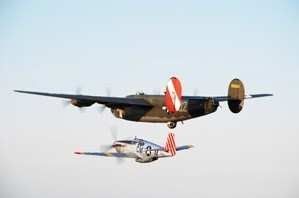Mon, May 17, 2010
A Summer Adventure Back In Time
The Collings Foundation is offering a very unique two-day
"training program" in which participants will train for and fly a
simulated WWII bombing mission. This is WWII Bomber School 101.
Attendees will learn what is needed to properly function in the
role of Navigator, Radio Operator, Gunner, Flight Engineer and
Bombardier aboard the Collings Foundation's B-24J Liberator
"Witchcraft".

The United States Army Air Forces was the military aviation arm
of the United States of America during and immediately after World
War II. The direct precursor to the United States Air Force, its
peak size was over 2.4 million men and women in service and nearly
80,000 aircraft in 1944. There were 783 domestic air bases in
December 1943. By VE Day the Air Corps had 1.25 million men
stationed overseas and operated from more than 1,600 airfields
worldwide. The Air Corps became the Army Air Forces in June 1941,
providing the air arm greater autonomy in which to expand more
efficiently, and to provide a structure for the additional command
echelons required by a vastly increased force.
The WWII Crew Fantasy Camp experience will be similar to what a
new recruit might have gone through during WWII, the "Readers
Digest" version of the AAFSAT (Army Air Force School of Applied
Tactics). The first segment of the training includes
familiarization of the B-24J Liberator inside and out, including
what it takes to keep the Liberator operational and effective.
Participants will study the roll and duty of every crew position.
Navigators will learn how to properly read aviation maps and get
the bomber to target using WWII methods, while Bombardiers will
learn how to operate the Norden bombsight and when to punch the
button on the "pickle" to drop the bombs. And the bombsight is
fully functional.
Gunners will learn all the skills needed to be an effective aerial
gunner. Initial training starts with being able to properly target
a moving object (skeet shooting), maintain and properly operate the
machine guns in each position and knowing how to operate the nose,
tail and ball turrets (if you can fit into these positions).

On mission day, mission papers will be distributed to the crew
and each will be given an assignment. The crew will climb aboard
"Witchcraft" and fly to the enemy, fire blank 50 cals. out the
waist gun, drop the bomb load on target, and get back to base
safely.
The camp will be held in Concorde, CA June 2-3. Day one will
include basic training, aircraft procedures and aircraft
familiarization. Day two will include target mission briefing and
the bomb run.
More News
“These new aircraft strengthen our ability to respond quickly, train effectively and support communities nationwide. Textron Aviation has been a steadfast supporter in helpin>[...]
From 2011 (YouTube Edition): Rugged, Legendary, STOL Twin Makes A Comeback The de Havilland Twin Otter is an airplane with a long history, and it gained a reputation as a workhorse>[...]
A Wind Gust Lifted The Right Wing And The Airplane Turned To The Left Analysis: The pilot was departing from a 2,395-ft-long by 50-ft-wide turf runway. The pilot reported that afte>[...]
Have A Story That NEEDS To Be Featured On Aero-News? Here’s How To Submit A Story To Our Team Some of the greatest new stories ANN has ever covered have been submitted by our>[...]
Braking Action Advisories When tower controllers receive runway braking action reports which include the terms “medium," “poor," or “nil," or whenever weather con>[...]
 Aero-News: Quote of the Day (12.18.25)
Aero-News: Quote of the Day (12.18.25) Classic Aero-TV: Viking Twin Otter 400--Bringing the DHC-6 Back Into Production
Classic Aero-TV: Viking Twin Otter 400--Bringing the DHC-6 Back Into Production NTSB Final Report: Rans Employee Flying Club Rans S-6ES Coyote II
NTSB Final Report: Rans Employee Flying Club Rans S-6ES Coyote II ANN FAQ: Submit a News Story!
ANN FAQ: Submit a News Story! ANN's Daily Aero-Term (12.18.25): Braking Action Advisories
ANN's Daily Aero-Term (12.18.25): Braking Action Advisories




